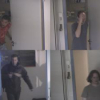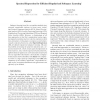ICCV
2007
IEEE
15 years 2 months ago
2007
IEEE
Most existing subspace analysis-based tracking algorithms utilize a flattened vector to represent a target, resulting in a high dimensional data learning problem. Recently, subspa...
ICCV
2007
IEEE
15 years 2 months ago
2007
IEEE
Particle filters encode a time-evolving probability density by maintaining a random sample from it. Level sets represent closed curves as zero crossings of functions of two variab...
ICCV
2007
IEEE
15 years 2 months ago
2007
IEEE
ICCV
2007
IEEE
15 years 2 months ago
2007
IEEE
ICCV
2007
IEEE
15 years 2 months ago
2007
IEEE
In this paper, we present the classification sub-system of a real-time video-based face identification system which recognizes people entering through the door of a laboratory. Si...
ICCV
2007
IEEE
15 years 2 months ago
2007
IEEE
Convolutional networks have achieved a great deal of success in high-level vision problems such as object recognition. Here we show that they can also be used as a general method ...
ICCV
2007
IEEE
15 years 2 months ago
2007
IEEE
The field of view of a traditional camera has a fixed shape. This severely restricts how scene elements can be composed into an image. We present a novel imaging system that uses ...
ICCV
2007
IEEE
15 years 2 months ago
2007
IEEE
Subspace learning based face recognition methods have attracted considerable interests in recent years, including Principal Component Analysis (PCA), Linear Discriminant Analysis ...
ICCV
2007
IEEE
15 years 2 months ago
2007
IEEE
An approach for fast tracking of arbitrary image features with no prior model and no offline learning stage is presented. Fast tracking is achieved using banks of linear displacem...
ICCV
2007
IEEE
15 years 2 months ago
2007
IEEE
We present a novel approach to reconstruction based superresolution that explicitly models the detector's pixel layout. Pixels in our model can vary in shape and size, and th...



